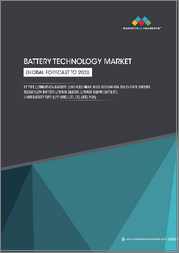
|
시장보고서
상품코드
1463792
세계의 철 플로우 배터리 시장 : 시장 규모 및 점유율 분석 - 종류별(레독스, 하이브리드), 용도별(유틸리티, 상업·산업, EV 충전소, 마이크로그리드), 재료별(바나듐, 아연-브롬) - 산업 수요 예측(-2030년)Iron Flow Batteries Market Size and Share Analysis by Type (Redox, Hybrid), Application (Utilities, Commercial and Industrial, EV charging stations, Microgrids), Material (Vanadium, Zinc Bromine) -Global Industry Demand Forecast to 2030 |
||||||
시장 개요
세계의 철 플로우 배터리 산업은 2023년말까지 2,690만 달러의 매출을 달성하며, 예측 기간 중 CAGR은 29.5%로 예측되며, 2030년까지 1억 6,350만 달러에 달할 것으로 추정됩니다. 이 배경에는 에너지 수요의 증가, 재생에너지원·태양광발전·풍력발전의 증가, 지방 전기화에 대한 정부의 지원, 전력 저장 장비의 장수명과 안전성, 연구개발 활동의 활발화 등이 있습니다.
주요 인사이트
데이터센터는 개인과 기업이 생성하는 방대한 양의 데이터를 저장, 처리, 처리하는 데 있으며, 중요한 역할을 담당하고 있습니다.
북미는 향후 수년간 약 50%의 성장률로 업계를 선도할 것으로 예상됩니다. 이 지역의 발전은 석유 및 가스, 화학, 발전 산업 증가에 기인합니다. 세계 대기업은 북미에 집중하고 있으며, 신제품을 적극적으로 출시하고 고객 기반을 확장하고 있습니다.
아시아태평양은 저렴한 노동력과 원자재로 인해 제조 부문의 중요한 거점이 되고 있으며, 예측 기간 중 30.4%의 연평균 복합 성장률(CAGR)로 성장할 것으로 예상됩니다.
세계의 철 플로우 배터리 시장을 분석했으며, 시장의 기본 구조·최신 상황 및 주요 촉진·억제요인, 세계 전체 및 지역별·주요 국가 시장 규모의 동향 전망(수량·금액 기반, 2017-2030년), 종류별·용도별·재료별의 상세 동향, 현재의 시장 경쟁 상황, 주요 기업의 개요 등을 조사하여 전해드립니다.
목차
제1장 조사 범위
제2장 조사 방법
제3장 주요 요약
제4장 시장 지표
제5장 업계의 전망
- 시장 역학
- 동향
- 촉진요인
- 억제요인/과제
- 촉진요인/억제요인의 영향 분석
- 신종 코로나바이러스 감염증(COVID-19)의 영향
- Porter's Five Forces 분석
제6장 세계 시장
- 개요
- 시장 규모 : 종류별(2017-2030년)
- 시장 매출 : 종류별(2017-2030년)
- 시장 규모 : 용도별(2017-2030년)
- 시장 매출 : 용도별(2017-2030년)
- 시장 규모 : 재료별(2017-2030년)
- 시장 매출 : 재료별(2017-2030년)
- 시장 규모 : 지역별(2017-2030년)
- 시장 매출 : 지역별(2017-2030년)
제7장 북미 시장
- 개요
- 시장 규모 : 종류별(2017-2030년)
- 시장 매출 : 종류별(2017-2030년)
- 시장 규모 : 용도별(2017-2030년)
- 시장 매출 : 용도별(2017-2030년)
- 시장 규모 : 재료별(2017-2030년)
- 시장 매출 : 재료별(2017-2030년)
- 시장 규모 : 국가별(2017-2030년)
- 시장 매출 : 국가별(2017-2030년)
제8장 유럽 시장
제9장 아시아태평양 시장
제10장 라틴아메리카 시장
제11장 중동 및 아프리카 시장
제12장 미국 시장
- 개요
- 시장 규모 : 종류별(2017-2030년)
- 시장 매출 : 종류별(2017-2030년)
- 시장 규모 : 용도별(2017-2030년)
- 시장 매출 : 용도별(2017-2030년)
- 시장 규모 : 재료별(2017-2030년)
- 시장 매출 : 재료별(2017-2030년)
제13장 캐나다 시장
제14장 독일 시장
제15장 프랑스 시장
제16장 영국 시장
제17장 이탈리아 시장
제18장 스페인 시장
제19장 일본 시장
제20장 중국 시장
제21장 인도 시장
제22장 호주 시장
제23장 한국 시장
제24장 브라질 시장
제25장 멕시코 시장
제26장 사우디아라비아 시장
제27장 남아프리카공화국 시장
제28장 아랍에미리트(UAE) 시장
제29장 경쟁 구도
- 시장 참여 기업과 제공 품목 리스트
- 주요 기업의 경쟁 벤치마킹
- 주요 기업의 제품 벤치마킹
- 최근 전략 개발 상황
제30장 기업 개요
- Sumitomo Electric Group
- ViZn Energy Systems
- Primus Power Solutions Private Limited
- ESS Inc.
- CellCube Inc.
- VRB Energy
- Invinity Energy Systems
- Lockheed Martin Corporation
- Largo Inc.
- Redflow Limited
제31장 부록
KSA 24.05.02Market Overview
The iron flow batteries industries are estimated to attain a revenue of USD 26.9 million by the end of 2023, with a projected CAGR of 29.5% over the projection period, mainly reaching USD 163.5 million by 2030. This can be credited to the rising need for energy, the addition of renewable power sources, solar and wind, government backing for rural electrification, the long-life cycle and security aids of these power storage devices, and rising R&D activities.
One of the main drivers of the growing market is the fact that very few cycles of charge and discharge could impair the capacity of these systems which almost makes them indestructible. This, thus, becomes a cost-efficient energy storage medium for both the short and long term. It is also the factor that allows this type of settlement to get rid of repair issues and to make possessions cheaper.
In addition, the developments in relevant technologies that worked to increase the specific energy density, cost-effectiveness, and performance of these batteries have made the market grow faster. The rescaling of these evolutions has been the center of attention hence resulting in a higher degree of competition in wider energy markets. What is more, battery energy storage plays a significant role in the industry of renewables, especially during high-generation periods.
Key Insights
Data centers play a vital role in storing, processing, and handling huge quantities of data produced by persons and businesses.
Data-intensive applications such as big data analytics, AI, and cloud computing propel the need for augmented data center capacity worldwide.
A dependable and constant energy supply is vital for data centers to guarantee swift functioning, with some of the prime data centers using more than 100 MW of electricity.
In recent times, decentralized or edge data centers that provide ubiquitous power solutions are gaining in number and thus require localized and efficient power infrastructure that is uninterrupted all the time.
The demand for reliable hardware generation and data center capacity is only sustainably itself with the growth of new digital services and applications.
Data center power storage systems, for example, flow batteries, are vital backup providers and can prevent downtime and ensure smooth operation by working during power outages.
The North American region is projected to lead the industry with an estimated development rate of 50% in the few coming years.
Development can be credited to the increasing oil & gas, chemical, and power generation industries in the continent.
Major players are focused in North America, vigorously introducing new products and growing their customer bases.
The growing requirement for renewable power storage systems and grid steadiness is propelling industry growth.
Iron flow batteries are witnessing rising usage in several applications such as microgrid, grid-scale, and stationary storage in the region.
The APAC region is projected to advance at a CAGR of 30.4% during the projection period because of cheap labor and raw materials, making it an important hub for manufacturing sectors.
Regional expenditures in renewable power projects are propelling market development.
Japan and Australia display a growing need for power storage systems in commercial, industrial, and utilities industries.
China's industry is estimated to advance significantly at a CAGR of 30.6%, with numerous working flow battery installations and large-scale industrial development.
Utility companies are deploying flow battery projects for grid-scale applications to manage grid stability and intermittent renewable energy sources.
Table of Contents
Chapter 1. Research Scope
- 1.1. Research Objectives
- 1.2. Market Definition
- 1.3. Analysis Period
- 1.4. Market Size Breakdown by Segments
- 1.4.1. Market size breakdown, by type
- 1.4.2. Market size breakdown, by application
- 1.4.3. Market size breakdown, by material
- 1.4.4. Market size breakdown, by region
- 1.4.5. Market size breakdown, by country
- 1.5. Market Data Reporting Unit
- 1.5.1. Volume
- 1.5.2. Value
- 1.6. Key Stakeholders
Chapter 2. Research Methodology
- 2.1. Secondary Research
- 2.1.1. Paid
- 2.1.2. Unpaid
- 2.1.3. P&S Intelligence database
- 2.2. Primary Research
- 2.3. Market Size Estimation
- 2.4. Data Triangulation
- 2.5. Currency Conversion Rates
- 2.6. Assumptions for the Study
- 2.7. Notes and Caveats
Chapter 3. Executive Summary
Chapter 4. Market Indicators
Chapter 5. Industry Outlook
- 5.1. Market Dynamics
- 5.1.1. Trends
- 5.1.2. Drivers
- 5.1.3. Restraints/challenges
- 5.1.4. Impact analysis of drivers/restraints
- 5.2. Impact of COVID-19
- 5.3. Porter's Five Forces Analysis
- 5.3.1. Bargaining power of buyers
- 5.3.2. Bargaining power of suppliers
- 5.3.3. Threat of new entrants
- 5.3.4. Intensity of rivalry
- 5.3.5. Threat of substitutes
Chapter 6. Global Market
- 6.1. Overview
- 6.2. Market Volume, by Type (2017-2030)
- 6.3. Market Revenue, by Type (2017-2030)
- 6.4. Market Volume, by Application (2017-2030)
- 6.5. Market Revenue, by Application (2017-2030)
- 6.6. Market Volume, by Material (2017-2030)
- 6.7. Market Revenue, by Material (2017-2030)
- 6.8. Market Volume, by Region (2017-2030)
- 6.9. Market Revenue, by Region (2017-2030)
Chapter 7. North America Market
- 7.1. Overview
- 7.2. Market Volume, by Type (2017-2030)
- 7.3. Market Revenue, by Type (2017-2030)
- 7.4. Market Volume, by Application (2017-2030)
- 7.5. Market Revenue, by Application (2017-2030)
- 7.6. Market Volume, by Material (2017-2030)
- 7.7. Market Revenue, by Material (2017-2030)
- 7.8. Market Volume, by Country (2017-2030)
- 7.9. Market Revenue, by Country (2017-2030)
Chapter 8. Europe Market
- 8.1. Overview
- 8.2. Market Volume, by Type (2017-2030)
- 8.3. Market Revenue, by Type (2017-2030)
- 8.4. Market Volume, by Application (2017-2030)
- 8.5. Market Revenue, by Application (2017-2030)
- 8.6. Market Volume, by Material (2017-2030)
- 8.7. Market Revenue, by Material (2017-2030)
- 8.8. Market Volume, by Country (2017-2030)
- 8.9. Market Revenue, by Country (2017-2030)
Chapter 9. APAC Market
- 9.1. Overview
- 9.2. Market Volume, by Type (2017-2030)
- 9.3. Market Revenue, by Type (2017-2030)
- 9.4. Market Volume, by Application (2017-2030)
- 9.5. Market Revenue, by Application (2017-2030)
- 9.6. Market Volume, by Material (2017-2030)
- 9.7. Market Revenue, by Material (2017-2030)
- 9.8. Market Volume, by Country (2017-2030)
- 9.9. Market Revenue, by Country (2017-2030)
Chapter 10. LATAM Market
- 10.1. Overview
- 10.2. Market Volume, by Type (2017-2030)
- 10.3. Market Revenue, by Type (2017-2030)
- 10.4. Market Volume, by Application (2017-2030)
- 10.5. Market Revenue, by Application (2017-2030)
- 10.6. Market Volume, by Material (2017-2030)
- 10.7. Market Revenue, by Material (2017-2030)
- 10.8. Market Volume, by Country (2017-2030)
- 10.9. Market Revenue, by Country (2017-2030)
Chapter 11. MEA Market
- 11.1. Overview
- 11.2. Market Volume, by Type (2017-2030)
- 11.3. Market Revenue, by Type (2017-2030)
- 11.4. Market Volume, by Application (2017-2030)
- 11.5. Market Revenue, by Application (2017-2030)
- 11.6. Market Volume, by Material (2017-2030)
- 11.7. Market Revenue, by Material (2017-2030)
- 11.8. Market Volume, by Country (2017-2030)
- 11.9. Market Revenue, by Country (2017-2030)
Chapter 12. U.S. Market
- 12.1. Overview
- 12.2. Market Volume, by Type (2017-2030)
- 12.3. Market Revenue, by Type (2017-2030)
- 12.4. Market Volume, by Application (2017-2030)
- 12.5. Market Revenue, by Application (2017-2030)
- 12.6. Market Volume, by Material (2017-2030)
- 12.7. Market Revenue, by Material (2017-2030)
Chapter 13. Canada Market
- 13.1. Overview
- 13.2. Market Volume, by Type (2017-2030)
- 13.3. Market Revenue, by Type (2017-2030)
- 13.4. Market Volume, by Application (2017-2030)
- 13.5. Market Revenue, by Application (2017-2030)
- 13.6. Market Volume, by Material (2017-2030)
- 13.7. Market Revenue, by Material (2017-2030)
Chapter 14. Germany Market
- 14.1. Overview
- 14.2. Market Volume, by Type (2017-2030)
- 14.3. Market Revenue, by Type (2017-2030)
- 14.4. Market Volume, by Application (2017-2030)
- 14.5. Market Revenue, by Application (2017-2030)
- 14.6. Market Volume, by Material (2017-2030)
- 14.7. Market Revenue, by Material (2017-2030)
Chapter 15. France Market
- 15.1. Overview
- 15.2. Market Volume, by Type (2017-2030)
- 15.3. Market Revenue, by Type (2017-2030)
- 15.4. Market Volume, by Application (2017-2030)
- 15.5. Market Revenue, by Application (2017-2030)
- 15.6. Market Volume, by Material (2017-2030)
- 15.7. Market Revenue, by Material (2017-2030)
Chapter 16. U.K. Market
- 16.1. Overview
- 16.2. Market Volume, by Type (2017-2030)
- 16.3. Market Revenue, by Type (2017-2030)
- 16.4. Market Volume, by Application (2017-2030)
- 16.5. Market Revenue, by Application (2017-2030)
- 16.6. Market Volume, by Material (2017-2030)
- 16.7. Market Revenue, by Material (2017-2030)
Chapter 17. Italy Market
- 17.1. Overview
- 17.2. Market Volume, by Type (2017-2030)
- 17.3. Market Revenue, by Type (2017-2030)
- 17.4. Market Volume, by Application (2017-2030)
- 17.5. Market Revenue, by Application (2017-2030)
- 17.6. Market Volume, by Material (2017-2030)
- 17.7. Market Revenue, by Material (2017-2030)
Chapter 18. Spain Market
- 18.1. Overview
- 18.2. Market Volume, by Type (2017-2030)
- 18.3. Market Revenue, by Type (2017-2030)
- 18.4. Market Volume, by Application (2017-2030)
- 18.5. Market Revenue, by Application (2017-2030)
- 18.6. Market Volume, by Material (2017-2030)
- 18.7. Market Revenue, by Material (2017-2030)
Chapter 19. Japan Market
- 19.1. Overview
- 19.2. Market Volume, by Type (2017-2030)
- 19.3. Market Revenue, by Type (2017-2030)
- 19.4. Market Volume, by Application (2017-2030)
- 19.5. Market Revenue, by Application (2017-2030)
- 19.6. Market Volume, by Material (2017-2030)
- 19.7. Market Revenue, by Material (2017-2030)
Chapter 20. China Market
- 20.1. Overview
- 20.2. Market Volume, by Type (2017-2030)
- 20.3. Market Revenue, by Type (2017-2030)
- 20.4. Market Volume, by Application (2017-2030)
- 20.5. Market Revenue, by Application (2017-2030)
- 20.6. Market Volume, by Material (2017-2030)
- 20.7. Market Revenue, by Material (2017-2030)
Chapter 21. India Market
- 21.1. Overview
- 21.2. Market Volume, by Type (2017-2030)
- 21.3. Market Revenue, by Type (2017-2030)
- 21.4. Market Volume, by Application (2017-2030)
- 21.5. Market Revenue, by Application (2017-2030)
- 21.6. Market Volume, by Material (2017-2030)
- 21.7. Market Revenue, by Material (2017-2030)
Chapter 22. Australia Market
- 22.1. Overview
- 22.2. Market Volume, by Type (2017-2030)
- 22.3. Market Revenue, by Type (2017-2030)
- 22.4. Market Volume, by Application (2017-2030)
- 22.5. Market Revenue, by Application (2017-2030)
- 22.6. Market Volume, by Material (2017-2030)
- 22.7. Market Revenue, by Material (2017-2030)
Chapter 23. South Korea Market
- 23.1. Overview
- 23.2. Market Volume, by Type (2017-2030)
- 23.3. Market Revenue, by Type (2017-2030)
- 23.4. Market Volume, by Application (2017-2030)
- 23.5. Market Revenue, by Application (2017-2030)
- 23.6. Market Volume, by Material (2017-2030)
- 23.7. Market Revenue, by Material (2017-2030)
Chapter 24. Brazil Market
- 24.1. Overview
- 24.2. Market Volume, by Type (2017-2030)
- 24.3. Market Revenue, by Type (2017-2030)
- 24.4. Market Volume, by Application (2017-2030)
- 24.5. Market Revenue, by Application (2017-2030)
- 24.6. Market Volume, by Material (2017-2030)
- 24.7. Market Revenue, by Material (2017-2030)
Chapter 25. Mexico Market
- 25.1. Overview
- 25.2. Market Volume, by Type (2017-2030)
- 25.3. Market Revenue, by Type (2017-2030)
- 25.4. Market Volume, by Application (2017-2030)
- 25.5. Market Revenue, by Application (2017-2030)
- 25.6. Market Volume, by Material (2017-2030)
- 25.7. Market Revenue, by Material (2017-2030)
Chapter 26. Saudi Arabia Market
- 26.1. Overview
- 26.2. Market Volume, by Type (2017-2030)
- 26.3. Market Revenue, by Type (2017-2030)
- 26.4. Market Volume, by Application (2017-2030)
- 26.5. Market Revenue, by Application (2017-2030)
- 26.6. Market Volume, by Material (2017-2030)
- 26.7. Market Revenue, by Material (2017-2030)
Chapter 27. South Africa Market
- 27.1. Overview
- 27.2. Market Volume, by Type (2017-2030)
- 27.3. Market Revenue, by Type (2017-2030)
- 27.4. Market Volume, by Application (2017-2030)
- 27.5. Market Revenue, by Application (2017-2030)
- 27.6. Market Volume, by Material (2017-2030)
- 27.7. Market Revenue, by Material (2017-2030)
Chapter 28. U.A.E. Market
- 28.1. Overview
- 28.2. Market Volume, by Type (2017-2030)
- 28.3. Market Revenue, by Type (2017-2030)
- 28.4. Market Volume, by Application (2017-2030)
- 28.5. Market Revenue, by Application (2017-2030)
- 28.6. Market Volume, by Material (2017-2030)
- 28.7. Market Revenue, by Material (2017-2030)
Chapter 29. Competitive Landscape
- 29.1. List of Market Players and their Offerings
- 29.2. Competitive Benchmarking of Key Players
- 29.3. Product Benchmarking of Key Players
- 29.4. Recent Strategic Developments
Chapter 30. Company Profiles
- 30.1. Sumitomo Electric Group
- 30.1.1. Business overview
- 30.1.2. Product and service offerings
- 30.1.3. Key financial summary
- 30.2. ViZn Energy Systems
- 30.2.1. Business overview
- 30.2.2. Product and service offerings
- 30.2.3. Key financial summary
- 30.3. Primus Power Solutions Private Limited
- 30.3.1. Business overview
- 30.3.2. Product and service offerings
- 30.3.3. Key financial summary
- 30.4. ESS Inc.
- 30.4.1. Business overview
- 30.4.2. Product and service offerings
- 30.4.3. Key financial summary
- 30.5. CellCube Inc.
- 30.5.1. Business overview
- 30.5.2. Product and service offerings
- 30.5.3. Key financial summary
- 30.6. VRB Energy
- 30.6.1. Business overview
- 30.6.2. Product and service offerings
- 30.6.3. Key financial summary
- 30.7. Invinity Energy Systems
- 30.7.1. Business overview
- 30.7.2. Product and service offerings
- 30.7.3. Key financial summary
- 30.8. Lockheed Martin Corporation
- 30.8.1. Business overview
- 30.8.2. Product and service offerings
- 30.8.3. Key financial summary
- 30.9. Largo Inc.
- 30.9.1. Business overview
- 30.9.2. Product and service offerings
- 30.9.3. Key financial summary
- 30.10. Redflow Limited
- 30.10.1. Business overview
- 30.10.2. Product and service offerings
- 30.10.3. Key financial summary
Chapter 31. Appendix
- 31.1. Abbreviations
- 31.2. Sources and References
- 31.3. Related Reports



















